-
This article tells about the architectural grandeur of monuments in Unakoti
Tripura, Bishnupur West Bengal, Konarak Odisha and Khajuraho Madhya Pradesh.
When foreigners plan an India visit the Golden Triangle, consisting of
Delhi, Agra and Jaipur, is a must see. Within that the Taj Mahal is a must see.
Nothing wrong with that but from an architectural standpoint there are monuments
across India that match if not exceed the Taj.
Part ONE covered Gujarat and Maharashtra. Monuments include Kailasa
Temple Ellora & Ajanta Caves in Maharashtra, Rani-ki-Vav Patan and Surya
Mandir Modhera in Gujarat.
Part TWO covered Tamil Nadu and Karnataka. Monuments include
Big Temple Thanjavur, Palaces of Chettinad, Mysore Palace, Badami Caves, Belur
Temples and Hampi.
Part three covers Unakoti, Bishnupur, Sun Temple and
Khajuraho. Format is about place, how to reach, name of guide & links to
albums of places to see.
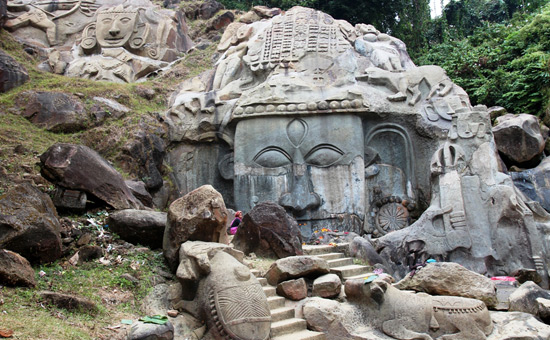 Unakoti Rock Carvings Tripura.
Unakoti Rock Carvings Tripura.
1 UNAKOTI Tripura - Rock Carvings
Visited 2014. I reached Silchar from Aizwal. Stayed at Kamadhenu
Hotel because the bus to Dharmanagar leaves from outside the hotel. Took bus at
5.30 am (Unakoti is 20 minutes from there). The minute the bus entered Tripura good
roads, forests & cleanliness welcomed us.
At the Dharmanagar bus stand are a number of private taxis
which take you to Unakoti, cost about Rs 500/ in 2014. Very scenic drive to
Unakoti, tea gardens on either side of the road.
“The marvellous rock carvings & murals
with their primitive beauty are a must see. Unakoti means one less than a crore,
it is believed these many rock cut carvings are available here.
These carvings are located at a beautifully landscaped
forest. The images found at Unakoti are rock-carved figures and stone images. Central
Shiva head and gigantic Ganesha figures deserve special mention. The central
Shiva head known as Unakotiswara Kal
Bhairava is about 30 feet high including an embroidered head-dress which
itself is 10 feet high. On each side of the head-dress of the central Shiva,
there are two full size female figures - one of Durga standing on a lion and
another female figure on the other side.”
How to reach, where to stay and how much time to spend
The
closest airport is Silchar (120 kms away) or fly to Agartala (171 kms away from
Dharmanagar). Keep 2-3 hours for seeing. Visit JAMPUI Hills close by, nice and
scenic.
Links to albums
1
Unakoti
2
Places
to see in Tripura
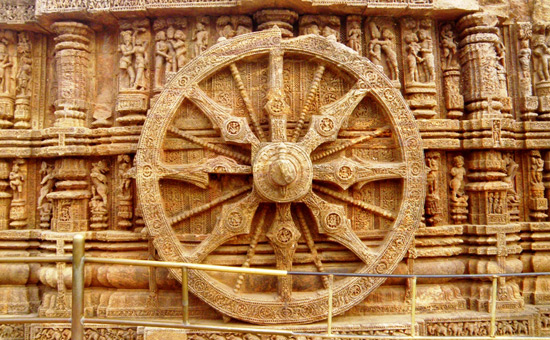 WHEEL, 2
by 16 spokes, 8 broad n 8 thin. Spokes minutely carved.
WHEEL, 2
by 16 spokes, 8 broad n 8 thin. Spokes minutely carved.
2 SUN TEMPLE
Konarak, Odisha
Temple
built by Raja Narsimhadeva of the Ganga dynasty. It was built in 1250 A.D. to
enshrine an image of Arka (Sun) the patron deity of the place. It resembles a
chariot with 12 pairs of wheels pulled by 7 galloping horses and has a 3 tiered
pyramidal roof topped off by a fine spire. 12 wheels represent 12 months of the
year. The chariot represents 7 days of the week and 24 hours of the day.
3 rock
types were used i.e. chlorite, laterite and khondalite. The masonry is ashlar.
The facing stones were smoothly finished and fitted together so finely that the
joints are hardly visible. The 8 spokes in each wheel symbolise the 8 prahars
(time frames) of the day.
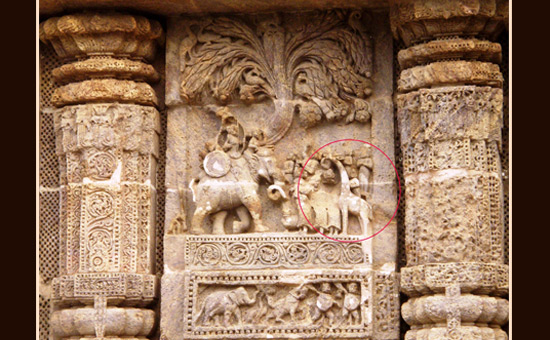 Area in red is
that of a Giraffe. Indicates trade relations with Africa during 13th century.
Area in red is
that of a Giraffe. Indicates trade relations with Africa during 13th century.
Photo
albums cover temple exhaustively. You must see the following -
1.
Motifs: elephants in various altitudes, military march and processions,
caravans.
2.
Platform: see ladies motives e.g. wringing water from wet hair, tail of snake.
3.
Deity: Navagarhas–Surya, Chandra, Mangala, Buddha, Brihaspati, Sukra etc
4.
Doorframe Panel: has 3 images – Siva, Shakti, and Vaishnav.
5.
Surya Chariot: Images of Sun God & Temple of Shadow or Chhaya Devi.
6.
Mithuna couples or exotic scenes.
7.
Natya Mandir.
8.
Ladies playing musical instruments
Do visit Chandrabhaga Beach and Museum close by. If you are
driving in from Bhubaneshwar do stop by at PIPLI for
local handicrafts.
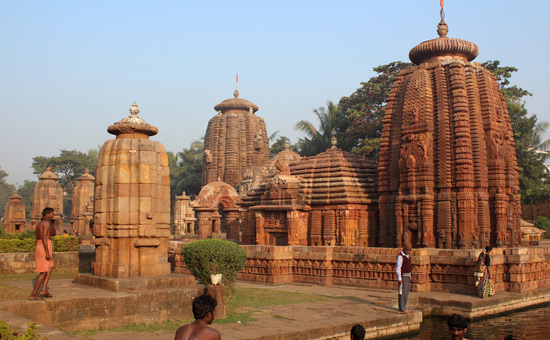 Mukteshwar Mandir Bhubaneshwar is a gem of Odisha temple architecture.
Mukteshwar Mandir Bhubaneshwar is a gem of Odisha temple architecture.
Muktesvara, made in late 10th
century is worth seeing. Temple spire rises up to 35 feet. The corners of the
sanctum tower or sikhara are
carefully rounded off, and the edges of the ratha-paga
projections are bevelled to a certain extent, with the result we see a graceful
& softened outline of the sikhara.
How to reach, where to stay, how much time to keep and Guide
Konarak
is 65 kms from Bhubaneshwar and 35 kms from Puri. Lots of hotels to stay at
various price points. Check out Orissa Tourism hotel too. If you start at 7 am
will finish seeing by say 3ish. Guides used Panda, 91 73776 66652 and Shankar, 91
99377 08364.
Links
to albums
1 Surya Mandir 1
2 Surya Mandir 2
3 Mukteshwar
Mandir Bhubaneshwar
4 Places to see in
Odisha
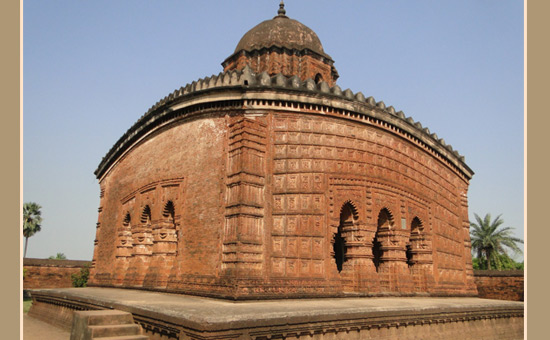 Madanmohan Mandir Bishnupur. Pic by Parthip Ray.
Madanmohan Mandir Bishnupur. Pic by Parthip Ray.
2 Terracota
Temples Bishnupur West Bengal
Since I have not travelled to Bishnupur taken matter from respected and famous travel writer Rangan Dutta blog. “Terracotta
literally means baked earth in Italian but West Bengal has the distinction of
housing some of the finest terracotta art in the world. The terracotta art
reached its pinnacle under the patronage of the Malla Kings of Bishnupur during
the seventeenth century.” 3
“The
Malla Kingdom flourished and after about 300 years the 10th Malla
King Jagat Malla decided to shift his kingdom to Bishnupur. Over the next 800
years Jagat Malla and his descendants built several temples and structures
(both of brick and stone) turning Bishnupur into a temple town.” 3
Temples
are located in a compact area so can walk around or hire a rickshaw. Temples
are -
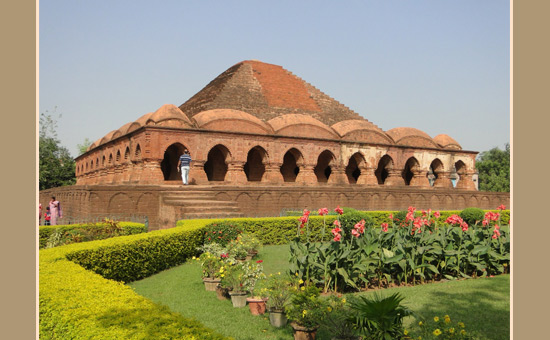 Rasmancha Temple, one of its kind in Bengal probably in India. Pic by Parthip Ray.
Rasmancha Temple, one of its kind in Bengal probably in India. Pic by Parthip Ray.
Rasmancha: “Built in 1600 by the Malla
King Hambir, the Rashmancha is the oldest standing structure of Bishnupur. It
is architecturally unique and one of its kind in the whole of Bengal, probably
in the whole of India.” 3
Shyamrai Temple: “A left turn from the
Ghumghar leads to the Shyamrai Temple, popularly known as the
Pachchura temple, because of its five pinnacles. Built by Mallaraja Raghunath
Singha in 1643 this is terracotta at its best.” 3
Kestorai Temple: “A short distance away from the
Shyamrai Temple is the Kestorai temple. It follows
the jora bangle style of architecture and hence is popularly known as the Jore
Bangle Temple.” Radhashyam
Temple: “Just next
to the Kestorai Temple is the Radhashyam Temple. This Ek – ratna (Single
Pinnacled) temple is built of laterite stone and contains lime stone stucco
decoration.” 3
Radha Laljiu Temple: “Built by the Malla King
Bir Singha in 1658 it is considered as the finest laterite stone temple in
Bishnupur.” Madan Mohan Temple: “This single
pinnacled temple has some of the finest terracotta in the whole of Bishnupur
and shouldn’t be missed. Built in1694 by Malla King Durjan Singh the star
attraction of Madan Mohan is its intricate terracotta.” 3
Also
see the Dalmadal Canon: Seven Ek –
Ratna Temples, Bishnupur Museum.
How to reach, where to stay and how much time to spend
Bishnupur
is 132 kms from Kolkata. Bishnupur is well connected from Howrah by train, take
Rupashi Bangla and Purilia Express. It has hotels at various price points. West
Bengal Tourism Lodge is an option. Bishnupur is famous for the
Baluchari saree and terracotta items.
Links
1 Bishnupur
Temples
2 West
Bengal Tourism site
3 Rangan
Dutta Blog on Bishnupur
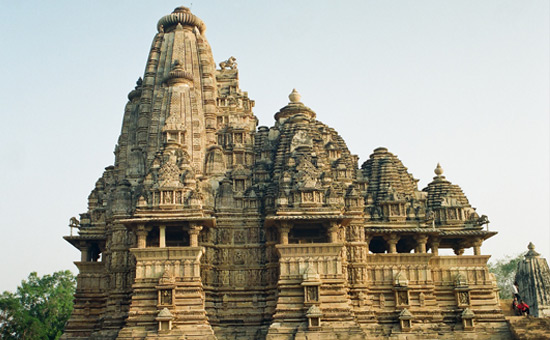 Vishwanatha Shiv Mandir Khajuraho.
Vishwanatha Shiv Mandir Khajuraho.
4 KHAJURAHO TEMPLES, Madhya Pradesh
Our
holiday route was Delhi, Gwalior, Jhansi, Orchha, Khajuraho, Chitrakoot,
Prayagraj and Kashi. The drive from Orchha to Khajuraho took about three hours
in 2008.
Khajuraho
has the best collection of temples at one place. Only Pattadakal temples in Karnataka
are comparable. Do see the Light & Sound Show. Temples were rediscovered in
the 1850’s. Of
the 85 temples only 20 have survived. Temples are divided into three groups.
The
Western group consists of Chausauth-yogini,
Lalgaun Mahadev, Varaha (900-925 A.D), Matangeshwara (900-925 A.D.), Parvati
(950-1000 A.D), Lakshmana (930-950 A.D), Vishwanatha (1002 A.D.), Nandi shrine,
Chitragupta (early 11th century), Devi Jagdambi (early 11th
century), ruined Shiva temple and Kandariya Mahadeva Mandir the best (1025-50
A.D.)
The
Eastern group consists of temples Brahma
(900 A.D.), statue of Hanuman, Vamana (1050-75 A.D.), Shantinath, Parshwanath
(mid-10th century), Adhinath (late 11th century), Ghantai
temple (late 10th century) and Javari temple (1075-1100 A.D.).
The
Southern group consists of temples Duladeo
(1100-50 A.D.) and Chaturbhuja temple (early 11th century). There is
an Archaeological Museum close to the temple. The information below is essentially
from board outside temple and given temple wise.
Visvanatha Mandir - “This temple is among the finest
monuments of Khajuraho and is dedicated to Lord Shiva. It was a Panchayatana (five shrine temples)
shrine but of the four subsidiary shrines only two in the northeast and
southwest have survived. The temple shows all the elements of the developed
Khajuraho temples – entrance porch (ardha mandapa), Mandapa, Maha Mandapa and
Sanctum enclosed by an ambulatory.”
A
Panchayatan temple consist of a large
central shrine which the principal shrine housing the deity to whom the temple
is dedicated, and four subsidiary shrines at the four corners of the platform
which are dedicated to the other members of the panchayat of Gods. The detached
Nandi pavilion forms an integral part
of the architectural scheme of the temple. The square pavilion rests on 12
pillars and enshrines a massive image of Nandi, the vehicle of Siva.
Pics of
Vishwanatha Mandir
Chitragupta Mandir – “The temple closely resembles the
Jagdambi temple and consists of a sanctum (Garbhagriha)
without ambulatory, avestibule (Antarala),
a Maha Mandapa with lateral transepts
and an entrance porch (Ardha Mandapa).
The main image in the sanctum is an impressive sculpture of Surya standing in a
chariot driven by seven horses. This is the only temple
in Khajuraho dedicated to Surya.
The temple walls are carved with some of the finest figures of Sura-Sundaris and an eleven headed Vishnu in the central niche of the South façade.”
Jagadambi Mandir – “Named for the image of Parvati now enshrined in
the sanctum, Jagdambi temple was originally dedicated to Vishnu. The lintel of
the Garabhagriha contains a 4 armed standing Vishnu figure.”
Pictures of
these temples
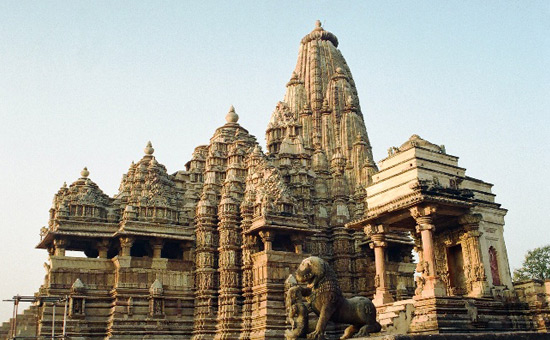 Kandhariya Mahadev Mandir Khajuraho, no words to describe it.
Kandhariya Mahadev Mandir Khajuraho, no words to describe it.
Kandariya Mahadeva Mandir - “The temple was built during 1025 to
1050 A.D, is the largest and loftiest monument of Khajuraho & dedicated to
Lord Shiva. It consists of an entrance porch (ardha mandapa), Mandapa, Maha
mandapa, Antarala (vestibule) and Garbhagriha (sanctum). The sanctum is enclosed
by a Pradakshinapatha (ambulatory
passage).”
Its
mature plan and design, dimensions and symmetrical proportions, superb
sculptural embellishment and architectural elaboration, all mark it out as the
most evolved of the central Indian building style and one of the most sublime
creations of Indian architecture.
The
temple has a lofty basement with elegantly ornamented mouldings including
friezes of elephants, horses, warriors and hunters, acrobats & musicians,
dancers, devotees etc.”
It
has an elegantly carved Torana decorated
with a kirtim ukha and a frieze of dancers and musicians. The lintel of the
sanctum is represented with a four armed Siva flanked by Brahma and Vishnu on
the right and left side respectively.
One
can count as many as 872 images of 2.5 feet to 3 ft in height on the walls of
the Kandariya temple, 674 on the Vishwanath temple. On the body of Varah in the
Varaha temple 672 images of Hindu Gods and Goddesses are carved.
Pictures of
Kandariya Mahadeva Temple
Varaha Mandir - “The shrine built on a loft plinth is simpler, has
an oblong pavilion with a pyramidal roof of receding tiers, resting on 14 plain
pillars. The temple enshrines the monolithic image of Varaha, the boar incarnation of Vishnu. The shrine is built
entirely of sandstone. It is dated circa 900-925 A.D.”
Lakshmana Mandir - “The temple dedicated to Vishnu was built by
Chandela ruler Yasovarman during 930-950 A.D. It is a sandhara temple of the
Panchayatana variety. The temple consists of all the principal elements of the
developed temple – the entrance porch (ardha mandapa), mandapa, maha mandapa,
antarala and garbhagriha.
Two
rows of sculptures including divine figures, couples and erotic scenes adorn
the wall surfaces. The sanctum doorway is of seven sakhas, the central one is decorated with various incarnations of
Vishnu. The lintel depicts Laxmi in the centre flanked by Brahma and Vishnu.
The sanctum contains an image of the 4 armed Vishnu.”
Matangeswara Mandir - is a place of worship. Dedicated to
Lord Shiva it has an 8 feet high lingam. Loved
the lingam, still part of me. Lots of devotees, some danced with peacock
feathers. Interesting they performed some sort of a dandiya dance with sticks.
Vamana Mandir - “The temple is
dedicated to the Vamana incarnation of Vishnu consisting on plan of a saptartha
sanctum vestibule, Mahamandapa with late-raltransepts and in entrance porch.
The sanctum is Niradhara and
enshrines an image of the 4 armed Vishnu flanked by Chakrapurusha on the left and Sankhapurusha
on the right.”
Pictures of Vamana
Temple
Eastern group of temples are –
Adhinath Mandir - “Temple is known after the enshrined image of Adhinatha. Originally encompassed all
the basic members of Nirandhara temple including Mandapa and Ardhamandapa now completely
lost. Built in the later part of 11th century A.D.”
Parsvanatha Mandir - “The largest and best preserved
amongst the old temples of Khajuraho has individual features of plan and
design.”
Pictures of Jain
Temples
Southern group of temples are -
Duladeo Mandir - “Dedicated to Siva, the temple faces the east and
consists of a sanctum without ambulatory, vestibule, mahamandapa and an
entrance porch. The Sikhara is clustered round by three rows of minor sikhara,
its Mahamandapa shows some peculiarities of design and decoration, the
Mahamandapa is octagonal showing 20 Apsaras bracket which are elaborately
crowned and heavily ornamented. Temple belongs to early half of 12th century.”
Chaturbhuja Mandir - “This is the only temple at Khajuraho
which lacks exotic sculptures. Except the vidyadhars the top rows are stereo
typed and without much life or expression. The image of Dakshinamurthi which is houses in the sanctum is remarkable for its
expression of transcendental calm and bliss. The temple is datable to 1100 A.D.”
How to reach and how much time to keep
There is a flight from Delhi to Khajuraho. The Khajuraho station is well
connected to Delhi and Kashi and (via Satna Railway Station) to Mumbai and
Kolkata. OR take train to Jhansi from
where Khajuraho is 172 kms, from Satna is 112 kms, from Chitrakoot 151 kms.
Lots of hotels at various price points. We stayed at the Madhya Pradesh one,
very nice.
There is so much to re-discover in east India. Unless otherwise stated
all pictures in article clicked by Sanjeev Nayyar.
Links
1 Detailed information about Khajuraho Temples
2 Madhya Pradesh Tourism website
Author is a travel photojournalist
and founder www.esamskriti.com